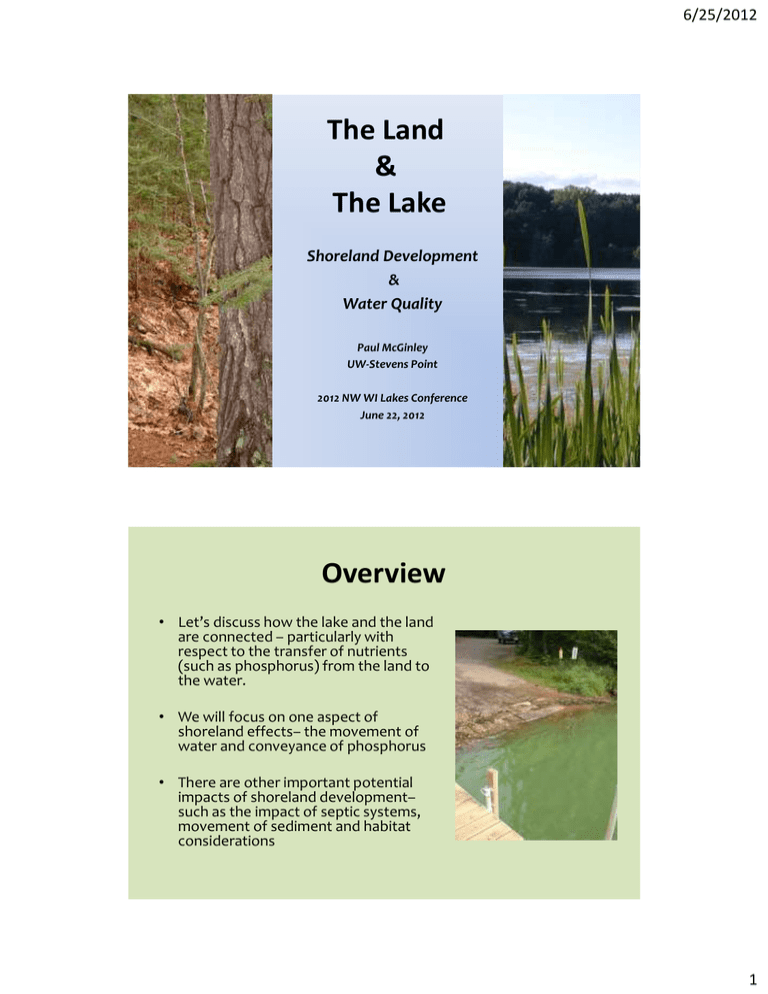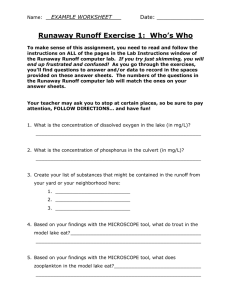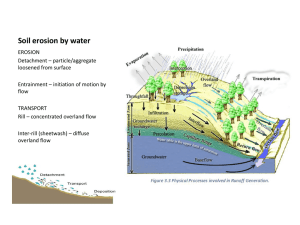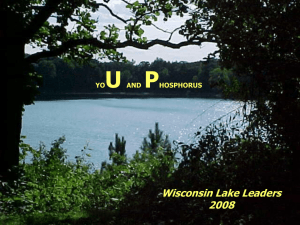The Land & The Lake Overview
advertisement

6/25/2012 The Land & The Lake Shoreland Development & Water Quality Paul McGinley UW-Stevens Point 2012 NW WI Lakes Conference June 22, 2012 Overview • Let’s discuss how the lake and the land are connected – particularly with respect to the transfer of nutrients (such as phosphorus) from the land to the water. • We will focus on one aspect of shoreland effects– the movement of water and conveyance of phosphorus • There are other important potential impacts of shoreland development– such as the impact of septic systems, movement of sediment and habitat considerations 1 6/25/2012 Overview • Part I – Intro to the Lake and the Land • Part 2 – Water Quality – Phosphorus • Part 3 – The Developed Shore The Lake 2 6/25/2012 200 acre 10’ average 650,000,000 gallons 200 acre 10’ average 3 6/25/2012 • Where did this water come from? • Where does it go? The Land (the watershed) 4 6/25/2012 1000 acres (example) 32”/year Baseflow Event Flow 5 6/25/2012 32”/year Evapotranspiration (22”/year) Baseflow Event Flow 32”/year Evapotranspiration (22”/year) Baseflow Event Flow Flow out of watershed = 10”/year 6 6/25/2012 32”/year Evapotranspiration (22”/year) Baseflow Event Flow Flow out of watershed = 10”/year = 270,000,000 gallons/year 270 million gallon/year 650 million gallons in lake 7 6/25/2012 270 million gallon/year 650 million gallons In lake Recap– Part I • There is a lot of water moving through our lakes • Almost all of the water in a lake has passed through land first • Water “connects” the lake to the land 8 6/25/2012 Water Quality • Definitions • Let’s look at phosphorus PO43- Water Quality • Definitions • Let’s look at phosphorus PO43- 9 6/25/2012 Assume 40 microgram P/l Assume 40 microgram P/l That’s 217 pounds P in the water 10 6/25/2012 How about the land? Let’s start with 1 acre 11 6/25/2012 70 lb plant P 80 lb organic matter P 400 lbs soil P (top 6”) 550 lb P /acre Adapted from Yanai, R.D., 1992. Phosphorus Budget of a 70-year-old northern hardwood forest Biogeochemistry 17:1-22 12 6/25/2012 1000 acre watershed = 550,000 lb P 200 acre lake = 217 lb P Just the first couple hundred feet around the lake could be more than 30,000 lbs 200 acre lake = 217 lb P 13 6/25/2012 Recap Part II • A lake contains 100’s of pounds of phosphorus • The land contains 100,000’s of pounds of phosphorus • Remember… a lot of water moves from land to lake • Why isn’t there more phosphorus in the lake? The Developed Shore--Phosphorus Chemistry & Biology • Very reactive • Incorporated quickly • 1) Percolate through soil– lots of time for reaction & filtering • 2) Run across soil—little time for reaction and little filtering • Let’s follow the water 14 6/25/2012 A lot of details - how much rain / over what time - amount of impervious area - dimensions of run-on area - infiltration characteristics Inches / 10 min 0.2 Rain 0.1 0.0 0 10 20 30 40 50 60 Minutes Run-on Runoff • • • Source Area: 500 ft2 Run-on Area: 40 ft x 5 ft Hourly time-step • • Compute Runoff as f (storm and infiltration) Annual hourly rainfall to estimate connection A few experiments Runoff Volume over Time Volume (liter) 20 18 16 14 12 10 5 7 8 3 6 4 2 0 0 50 100 150 200 250 300 350 400 Time (sec) 15 6/25/2012 Let’s look at the importance of storm size & infiltration rate How much water runs off? First--- what size of storm? Look at typical hourly precipitation 1000 Hours / Year 100 ¼ inch/hour 10 1 0.1 0.01 0.1 0.2 0.3 0.4 0.5 0.6 0.7 0.8 1 1.1 1.2 1.3 1.4 1.5 1.6 1.7 1.8 1.9 2 Inches / Hour Based on P8 hourly rainfall File for 36 years, Madison 16 6/25/2012 1000 Hours / Year 100 ½ inch/hour 10 1 0.1 0.01 0.1 0.2 0.3 0.4 0.5 0.6 0.7 0.8 1 1.1 1.2 1.3 1.4 1.5 1.6 1.7 1.8 1.9 2 Inches / Hour Based on P8 hourly rainfall File for 36 years, Madison Second… how fast does the water infiltrate (percolate) into the ground? Measure in inches/hour Typical range? What controls this? 17 6/25/2012 Fraction of Runon That Runs Off Then combine that with different soil infiltration rates 1.5 1.3" ¼ - ½ inch/hour 1 0.5" 0.5 0.25" 0.1" 0 0.01 0.1 1 10 Infiltration Rate (in/hr) The fraction of runon to the secondary buffer that would infiltrate for different storm sizes and infiltration rates (assumes a 500 ft2 impervious area draining to a five foot wide channel, forty feet long and one hour storm of depth shown). Dashed lines show the fitted equation based on soil infiltration rate and storm depth. Runon Ratio 500 / 5(w) x 40 (L) Fraction of Runon That Runs Off What controls the infiltration rate? 1.5 CLAYEY SILTY SANDY 1.3" ¼ - ½ inch/hour 1 0.5" 0.5 0.25" 0.1" 0 0.01 0.1 1 10 Infiltration Rate (in/hr) Runon Ratio 500 / 5(w) x 40 (L) The fraction of runon to the secondary buffer that would infiltrate for different storm sizes and infiltration rates (assumes a 500 ft2 impervious area draining to a five foot wide channel, forty feet long and one hour storm of depth shown). Dashed lines show the fitted equation based on soil infiltration rate and storm depth. 18 6/25/2012 Factors Controlling Water Movement What about compaction? Condition Ponded Infiltration Rate (in/hr) Vegetated 3.4 Open Soil 0.7 Traffic 0.1 Silt loam soil described by Vervoort, R.W., S.M. Dabney and M.J.M. Romkens. 2001. Tillage and Row Position Effects on Water and Solute Infiltration Characteristics, Soil Science Society of America Journal 65:1227-1234. Let’s go back to our lake (let’s make it just a bit more complex… say ~180 lb/year into the lake will maintain about 217 lb in the lake) 180 lb P/year 90 lb/yr 217 lb P 90 lb/yr 19 6/25/2012 Back of the envelope comparison groundwater versus surface runoff 1 mg/l 0.02 mg/l Back of the envelope comparison groundwater versus surface runoff 1 mg/l 10 inches/year 0.02 mg/l 2.3 pound/acre/yr 0.05 pound/acre/yr 20 6/25/2012 Back of the envelope comparison groundwater versus surface runoff 10 inches/year 1 mg/l 0.02 mg/l 2.3 pound/acre/yr 0.05 pound/acre/yr 2300 lb/1000 acres 50 lb/1000 acres Then why so complicated? Taken from McGinley et al Presented at the WI-AWRA Conf March 2010 21 6/25/2012 Summary • Water connects land and water • Land is a concentrated source of nutrients • Increase overland flow paths– increase concentration of P – increase phosphorus transfer Recommendations • Make it hard for the water to get to the lake • Increase infiltration rates and direct runoff to high infiltration areas • Don’t compact • Don’t shape to the lake 22 6/25/2012 Let’s keep talking • Paul McGinley • (715) 346-4501 • paul.mcginley@uwsp.edu 23




